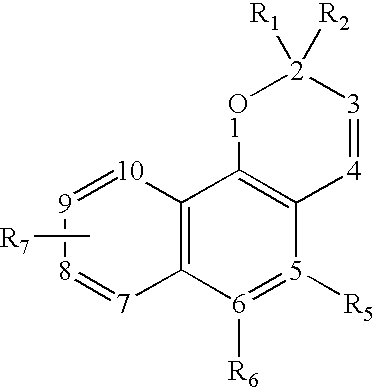Oxygen-containing heterocyclic fused naphthopyrans
- Summary
- Abstract
- Description
- Claims
- Application Information
AI Technical Summary
Problems solved by technology
Method used
Image
Examples
example 1
[0124]
[0125]Step 1: To a reaction flask containing 2,3-dihydrobenzofuran (13.5 grams) and benzoyl chloride (16.6 grams) in 170 milliliters (mL) of methylene chloride were added anhydrous aluminum chloride (18.0 grams) under nitrogen blanket over 40 minutes. The reaction temperature was controlled at around 25° C. with an ice / water bath. The reaction mixture was stirred at room temperature overnight. The resulting mixture was poured into 150 mL of ice / water and stirred vigorously for 30 minutes. The organic layer was separated, washed with water, dried over magnesium sulfate. The methylene chloride solvent was removed by rotary evaporation to give 25 grams of thick pink oil. It is used ‘as is’ in the next step.
[0126]Step 2: The product from Step 1 (25 g), dimethyl succinate (21.0 g), and potassium t-butoxide (16.5 g) were mixed in 250 ml of toluene. The mixture was refluxed for 2 hours under nitrogen blanket. After it was cooled to room temperature, 200 ml of water was added and mixe...
example 2
[0134]Step 1: Compound 1-3-p1 from Step 3 of Example 1 (1.85 g) was mixed with 50 ml of methanol and 1 ml of concentrated HCl. The mixture was refluxed for 7 hours before it was cooled down to room temperature. 100 ml of water was then added. The product was extracted with 200 ml ether and followed by separation, drying over magnesium sulfate, filtering, and vacuum drying to yield 1.55 g of very light yellow powder.
[0135]Step 2: The product of Step 1 (0.5 g) was dissolved in 10 ml of THF, and 4 ml of cyclopentylmagnesium bromide (2M in ether) was dropped in at room temperature. After stirring for 2 days, few mililiters of 1N HCl was added in. The mixture was extracted with toluene, dried over magnesium sulfate, filtered, and concentrated to a solid paste. The paste was then washed with hexane to provide 0.64 g of off-white powder.
[0136]Step 3: The product from Step 2 (0.56 g) was mixed with 10 wt. % p-toluenesulfonic acid and 50 ml of toluene. The mixture was refluxed for one and ha...
example 3
[0138]
[0139]Step 1: Steps 2 and 3 of Example 2 were followed. except that cyclopentylmagesium bromide was replace by n-butylmagnesium chloride (3M in ether). In this case, two products were obtained as Compound 3-1-a (0.08 g) and 3-1-b (0.15 g). They are light yellow waxy solid.
[0140]Step 2: Compound 3-1-b (0.12 g) was reacted with 1,1-di(4-methoxyphenyl)-2-propyn-1-ol (0.24 g) in 20 ml of toluene and catalytic amount of p-toluenesulfonic acid for 50 minutes at 50 to 80° C. After concentrated and purified by a silica column with 1:20 ethyl acetate / hexane as eluent, 140 mg of white powder was obtained. Its structure was confirmed by NMR.
PUM
 Login to View More
Login to View More Abstract
Description
Claims
Application Information
 Login to View More
Login to View More - R&D Engineer
- R&D Manager
- IP Professional
- Industry Leading Data Capabilities
- Powerful AI technology
- Patent DNA Extraction
Browse by: Latest US Patents, China's latest patents, Technical Efficacy Thesaurus, Application Domain, Technology Topic, Popular Technical Reports.
© 2024 PatSnap. All rights reserved.Legal|Privacy policy|Modern Slavery Act Transparency Statement|Sitemap|About US| Contact US: help@patsnap.com










